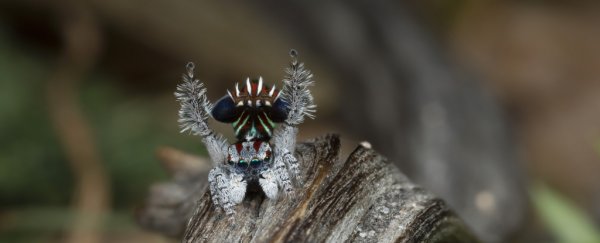You wouldn't expect an animal to be too judgemental about looks. Surely they have more important things to worry about like foraging, hunting, migrating, and keeping their offspring alive. But the incredible array of bright, shimmering colours; complex patterns; and elaborate plumage we see throughout the animal kingdom suggests that for many species, maintaining your looks is just as important as keeping your survival skills up to scratch.
For peacock spiders, 'hotness' is all about how they flaunt their colourful tummies, for peacocks, it's the number of beautiful eyespots they can show off in ther tails. And for red deer, it's all the size of the male's… antlers. So why have animals evolved this sense of what is, and what isn't, beautiful?
Darwin would say it's all about evolution, and being the 'chosen one' when it comes to mating and reproducing. Known as sexual selection, the theory is that outward attractiveness is a more desirable trait, but this force also drives the evolution of increasingly elaborate displays, sometimes to the detriment of an individual's survival skills. Take the long plumes of certain species of birds of paradise, for example. They might be beautiful to the opposite sex, but they're also cumbersome, and can easily attract predators.
In this sense, sexual selection - being hot - and natural selection - being more fit for survival - don't always equal the same genetic result. So why do animals desire attractive partners, not well-rounded ones? "You can't take it for granted that organisms had a sense of aesthetic beauty and that it drove the whole sexual selection process," evolutionary biologist Adam Jones of Texas A&M University in the US told Melissa Hoggenboom at BBC Earth. "Scientists had to explain why they had that sense, why do they care about beauty?"
American evolutionary biologist Robert Trivers proposed the prevailing explanation in the 1970s: it all comes down to the effort an animal puts into their parenting. "If one parent has to put a lot of time and effort into rearing their young, they are likely to be much fussier about picking the right partner, compared to parents whose offspring need little attention," writes Hoggenboom.
Trivers's idea was backed up by a 1994 study, which found that while peacocks with bigger plumes may be more vulnerable to attackers, but they also have healthier offspring.
The other part of this is what's known as the handicap principle: growing a big tail and carrying it around ain't easy, so you must be pretty fit to be able to do so.
But what about humans? For our species, beauty is all about having face symmetry. And, unlike many species, both sexes care about attractiveness. "Males prefer females with ideal waist-to-hip ratios, while females prefer deeper voices and squarer jaws. Like the peacock's tail, these traits are honest markers of health and resistance to parasites, and are hard to fake," writes Hoggenboom at BBC Earth.
They also indicate fertility, with attractive traits in males linked to higher testosterone and attractive traits for females linked to oestrogen. "Both of these hormones are linked to fertility," says Hoggenboom. Studies on other primates suggest this is something we've evolved. "The bottom line is, if there are some individuals which aren't as good as picking out fertile genes, they will be selected out," Glenn Sheyd of Nova Southeastern University in the US, told her.
